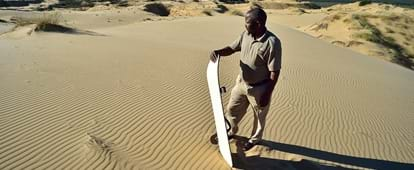By creating an account, I agree to the
Terms of service and Privacy policy
Choose your country and language:
Africa
Americas
Asia Pacific
Europe
WWitsand Nature Reserve in Northern Cape province hosts a natural attraction that is one of the Green Kalahari’s best-kept secrets: geological and climatic anomalies cause the desert sands to ‘roar'. This exceptional eco-destination offers visitors extraordinary birding opportunities as well as plenty of dryland wildlife.
Against the rust-red sands of the Kalahari, the ‘roaring’ white sand dunes of Witsand Nature Reserve already stand out as a mysterious natural phenomenon. The pale dunes are believed to have emerged from an isolated range of hillocks buried beneath the sand, from which springs a natural reservoir of underground moisture that, over millions of years, gradually leached the red iron oxide from the dunes, turning them white.

KKnown as Witsand’s Roaring Sands or, in Afrikaans, Brulsand, countless millions of grains on the dunes rub together to emit a deep reverberating hum. For the sands to roar, however, very hot and dry conditions are necessary.
So, although the Kalahari, is warm all year round, the hottest months from September to April are the most likely time to experience this extraordinary sand chorus. More of a rumble than a roar, one must be close to the dunes to hear their unique sound.
Another natural phenomenon that occurs here are fulgurites: glass-like tubes of sand formed when lightning from summer thunderstorms strikes the white sand dunes. Due to the high water-table and the elevation of the dunes, this is a frequent occurrence, fusing the silicon dioxide in the sand into tiny fragments of glass.

AA self-drive or guided trip to the Roaring Sands is just one of the tours offered at Witsand Nature Reserve. The park supports a wealth of small mammals, including meerkats, pangolins and aardvarks. There are also large antelope like red hartebeest, springbok, kudu and gemsbok (oryx).
During a night game drive, guests may chance upon porcupine, aardwolf, bat-eared fox, Cape fox, genet, springhare and owl, not to mention those rarities mentioned already, the pangolin and aardvark. Guided stargazing tours among the dunes are another highlight, courtesy of Northern Cape’s vast, unpolluted skies.
Though Witsand appears sparsely vegetated, 3 major arid-region and bushveld vegetation types converge in this region of the Kalahari, attracting more than 170 species of birds. The reserve offers a botanical meander in which guests can learn more about Witsand’s endemic and indigenous flora.
An ideal destination to unwind and appreciate unspoilt nature at a relaxed pace, Witsand Nature Reserve will also satisfy adventure enthusiasts. There are challenging 4x4 (SUV) routes, hiking trails, cycle trails and dune boards for hire.
Whether visiting for the photo opportunities or in aural pursuit of the Roaring Sands, Witsand Nature Reserve promises you an unforgettable stay.
TTravel tips & Planning info
Who to contact
Witsand Nature Reserve:
Tel: +27 (0)53 313 1061
Email: reception@witsandkalahari.co.za
How to get here
From Johannesburg the drive to Witsand Nature Reserve will take about 8 hours. Travel to Kuruman via Vryburg on the N14, then travel 45km to Kathu. From Kathu drive 27km to Olifantshoek and take the turn-off to your right. Four kilometres outside Olifantshoek en-route to Upington (N14), turn left towards Witsand, and follow the gravel road for 75km to Witsand.
Alternatively, fly to Upington or Kimberley airport, and hire a car to drive to Witsand. Estimated driving time from both airports is around 3 hours. There is no fuel station at Witsand.
Best time to visit
Between September and April is the best time to experience the Roaring Sands. But be warned: it can be extremely hot at this time.
Get around
You'd need your own vehicle, preferably a 4x4 (SUV) low-range vehicle or sedan car with good ground clearance.
Things to do in the area
At Kathu visit the camel thorn tree forest, at Kuruman visit ‘The Eye’ – a permanent spring-fed oasis – the golf club, or the Moffat missionary church.
What will it cost?
Accommodation ranges from approximately R100 per person to camp and between R160 and R440 for self-catering chalets, to R1 500 for an all-inclusive experience package (excludes transport).
Length of stay
At least two nights.
What to pack
Temperatures in desert environs can be extreme. Pack accordingly. Severe sunburn is a risk from the reflective white sands. Bring sun protection and high-factor sun creams. Winter nights can be icy.
What to eat
The inclusive packages are fully catered. Self-catering guests should bring their own food, especially fresh produce.
Related Links

